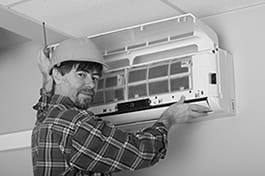Profession heating, ventilation, air conditioning and refrigeration engineering technician

Refrigeration mechanics service, adjust, test and repair industrial and commercial refrigerating systems and a variety of refrigeration equipment.
Would you like to know what kind of career and professions suit you best? Take our free Holland code career test and find out.
Personality Type
Tasks heating, ventilation, air conditioning and refrigeration engineering technician
- Gather information about the functioning of the refrigeration system.
- Analyze and interpret the (malfunctioning) history of the system.
- Check the state and condition of the refrigeration system.
- Perform preventive and corrective maintenance services, for example check and test leak detection devices, replace parts where necessary.
- Analyze and interpret defects in refrigeration systems.
- Repair malfunctioning refrigeration systems.
- Control and test whether defects are adequately repaired.
- Put refrigeration systems into operation (e.g. charge with refrigerant, adjust the thermostat and pressure control).
- Dismantle (parts of) refrigeration systems.
- Register relevant information, for example by completing a log book or forms.
Related professions electrical
- Building electrician
- Cooling or freezing installer or mechanic
- Domestic appliances service technician
- Domestic appliances technician
- Electrical line installer or repairer
- Electrical mechanic or fitter
- Electrician helper
- Electrician high voltage
- Electronic home entertainment equipment service technician
- Elevator installer or repairer
- Heating installer or mechanic
- Moving staircase installer or repairer
- Security or fire alarm systems installer or repairer
- Stage or studio electrician
- Windmill installer or repairer
Knowledge
- Hydraulics
The power transmission systems that use the force of flowing liquids to transmit power.
- Thermodynamics
The branch of physics that deals with the relationships between heat and other forms of energy..
- Mechanical engineering
Discipline that applies principles of physics, engineering and materials science to design, analyse, manufacture and maintain mechanical systems.
- Heating, ventilation, air conditioning and refrigeration parts
The different parts constituing heating, air conditioning and refrigeration systems such as the different valves, fans, compressors, condensers, filters and other components.
- Refrigerants
The characteristics and properties of the different fluids used in heat pump and refrigeration cycles.
Skills
- Ensure compliance with environmental legislation
Monitor activities and perform tasks ensuring compliance with standards involving environmental protection and sustainability, and amend activities in the case of changes in environmental legislation. Ensure that the processes are compliant with environment regulations and best practices.
- Use testing equipment
Use equipment to test performance and operation of machinery.
- Interpret 2D plans
Interpret and understand plans and drawings in manufacturing processes which include representations in two dimensions.
- Monitor utility equipment
Monitor equipment which provides utility services such as power, heat, refrigeration, and steam, in order to ensure they are functional, operate according to regulations, and to check for faults.
- Interpret 3D plans
Interpret and understand plans and drawings in manufacturing processes which include representations in three dimensions.
- Handle refrigerant transfer pumps
Handle the different transfer pumps used to keep a refrigerant in the liquid phase at the right pressure for an optimal accuracy and speed of the charging station.
- Maintain records of maintenance interventions
Keep written records of all repairs and maintenance interventions undertaken, including information on the parts and materials used, etc.
- Conduct routine machinery checks
Check machinery and equipment to ensure reliable performance during use and operations in worksites.
- Apply health and safety standards
Adhere to standards of hygiene and safety established by respective authorities.
Optional knowledge and skills
install heating furnace lay pipe installation install firestops install air conditioning device resolve equipment malfunctions examine engineering principles install electrical and electronic equipment lead a team install heating boiler drain hazardous liquids install ventilation equipment use personal protection equipment install heating, ventilation, air conditioning and refrigeration ducts perform maintenance on installed equipment arrange equipment repairsSource: Sisyphus ODB